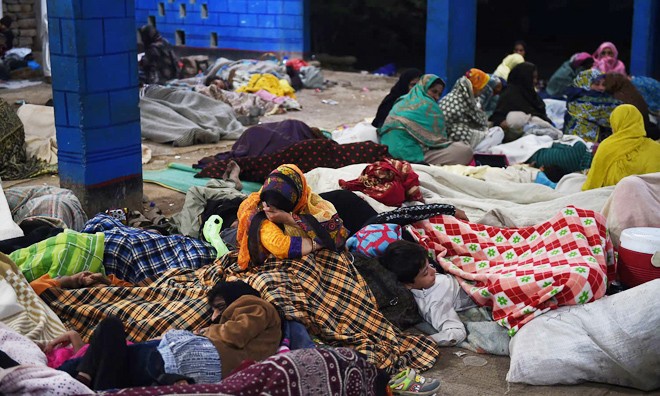
The massive and deadly attack on Shah Noorani shrine proves the expanding and evolving theatre of Islamist terror

The devastating suicide attack on Shah Noorani shrine in Khuzdar has underscored the fact that Islamist threat in Balochistan is both evolving and expanding. Initially inter-sectarian, the militant landscape has, apparently, also acquired intra-sectarian character. Similarly, it is political too. The toxic ideology of militant Deobandism under the unsavoury influence of Wahabism gives rise to Islamist terror in Balochistan.
If the year 1999 is taken as starting point of Islamist perpetrated violence in Balochistan, the nature of violence was inter-sectarian. The high profile incident of anti-Shia violence was carried out on October 6, 1999 when Sardar Nisar Ali Khan, an ethnic Hazara, Shia and Balochistan’s education minister, was wounded in a hit-and-run attack while his driver and guard were reportedly killed.
Nevertheless, sectarian violence perpetrated by Deobandi militants from Lashkar-e-Jhangvi (LeJ) became bloodier with the passage of time. On June 8, 2003, eight Hazara police cadets were killed by two armed men on motorcycle in Quetta city. Then there is a long list of Hazaras killed en masse in a string of deadly attacks ranging from bomb blasts to suicide attacks to target killings since June 8, 2003 to 2014 through.
The militant violence inflicted by the predominantly Deobandi Taliban associated with Tehreek-i-Taliban Pakistan (TTP) is also political. They, emerging shortly after the US-led invasion of Taliban-governed Afghanistan, stood for bringing about a Taliban type Shariah regime in Pakistan.
Flushed out from Afghanistan, initially they relocated to Pakistan’s tribal areas, primarily North and South Waziristan. They found themselves on the run whenever a military operation was launched in the six of the seven tribal agencies. The state’s security apparatus, military installations, police and paramilitary troopers were Taliban’s favourite targets in the rest of Pakistan though Balochistan was a late entry.
After the launching of Zarb-i-Azb in North Waziristan, the last of the tribal agencies to experience a major military operation, in June 2014, some of the anti-state Taliban ended up in Afghanistan’s bordering areas with Pakistan, others went into hiding or relocated to various parts of the country including Balochistan. A conglomerate of more than 40 militant outfits, the TTP was an umbrella organisation for Deobandi militant Islamists with two broad agendas: political and sectarian with religion playing an overarching role.
In Balochistan, the recent spike in violence is perpetrated by multiple splinter factions of the TTP in the service of their political and sectarian objectives. Although these groups may have parted ways, operationally they appear to be in cahoots with one another. What brings these all militant groups on the same page is their unwavering commitment to a distorted version of Deobandi Islam under Wahabi influence.
The massive suicide attack on Shah Noorani shrine added a third dimension of Islamist terror in Balochistan. The nature of terror is intra-sectarian. Deobandi militants, like their Wahabi/Salafi counterparts, exhibit strong antipathy towards reverence to shrines as practiced among Barelvi Sunnis and Shia Muslims. Visiting shrines and participating in various activities such as Dhammal -- a Sufi dance performed by devotees -- and Nazr-o-Niaz -- literally offering of less valuable thing in the hope of getting more valuable thing -- are considered equivalent to mockery of religion bordering on idolatry and heresy punishable by death.
The militant Deobandis have a very constrictive interpretation of religion. Even the otherwise very conservative religious leaders, the likes of Maulana Fazlur Rehman, do not qualify for being pious Muslims. It should not come as a surprise that the JUI-F chief has survived three suicide attacks.
The Quetta suicide attack on October 22, 2014 was claimed by Jundullah, the otherwise anti-Shia militant outfit.
The most worrying scenario is that all three recent suicide attacks in Balochistan carry the footprints of ISIS. While al-Qaeda introduced suicide attacks inside Pakistan, the Islamic State group is even more savage. The issue with state’s denial of ISIS’s presence is that those at the helm of affairs equate ISIS with the possession of some territory, which has been terror group’s hallmark both in Iraq and Syria.
To the extent that ISIS does not occupy any territory in Pakistan, which it won’t for the foreseeable future, the official stance carries due weight. Nevertheless, what appears is that ISIS has established links with local terrorist groups such as Lashkar-i-Jhangvi (LeJ) and Jammat-ur-Ahrar, a breakaway faction of TTP. What it requires for a militant to be part of Islamic State group is simply to switch allegiance from one group to the terrorist entity. Just take the example of Islamic State Afghanistan chapter. Militants previously affiliated with Afghan Taliban defected to establish Islamic State group in that country. The recent surge in Deobandi militancy in Balochistani is a bad omen for how bleak the future may look like.
It seems that Balochistan is playing Fata post Taliban collapse in Afghanistan when militants from al-Qaeda, Afghan Taliban and Uzbeks of Islamic Movement of Uzbekistan among others flocked to Pakistan’s tribal areas in the northwest. Seemingly, Balochistan, especially its metropolitan city Quetta and its suburb areas, is increasingly becoming Taliban’s new centre as fleeing militants are relocating there.
Seeking powers under FCR is not a rational move on the part of Balochistan government to prevent terror. Trimming the list of good Taliban was a rational move by the government though it took too long to do so. Nevertheless, much needs to be done. Until the good and bad Taliban distinction is laid to rest we can never get rid of terror perpetrated by non-state actors because every good Talib is a potentially bad Talib. Today’s all bad Taliban were once good Taliban. The longer we take to realise it, the further we shall suffer!